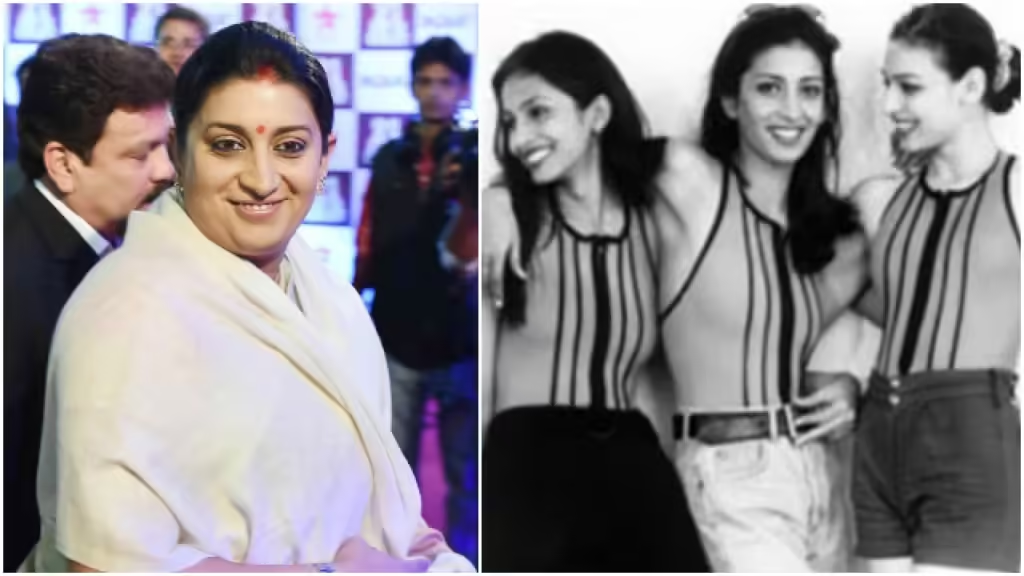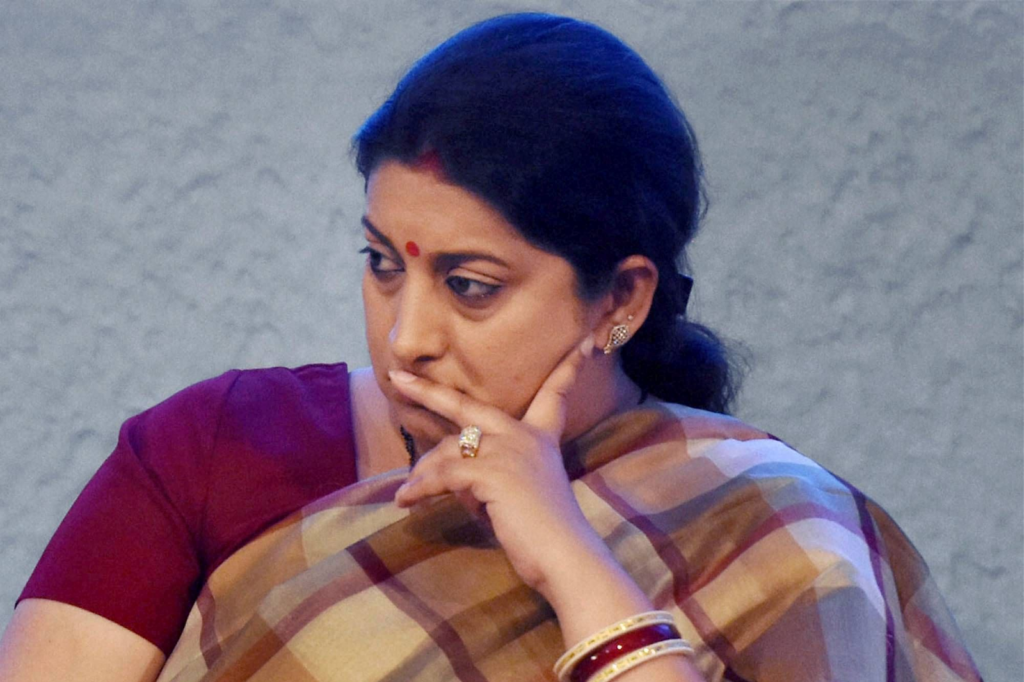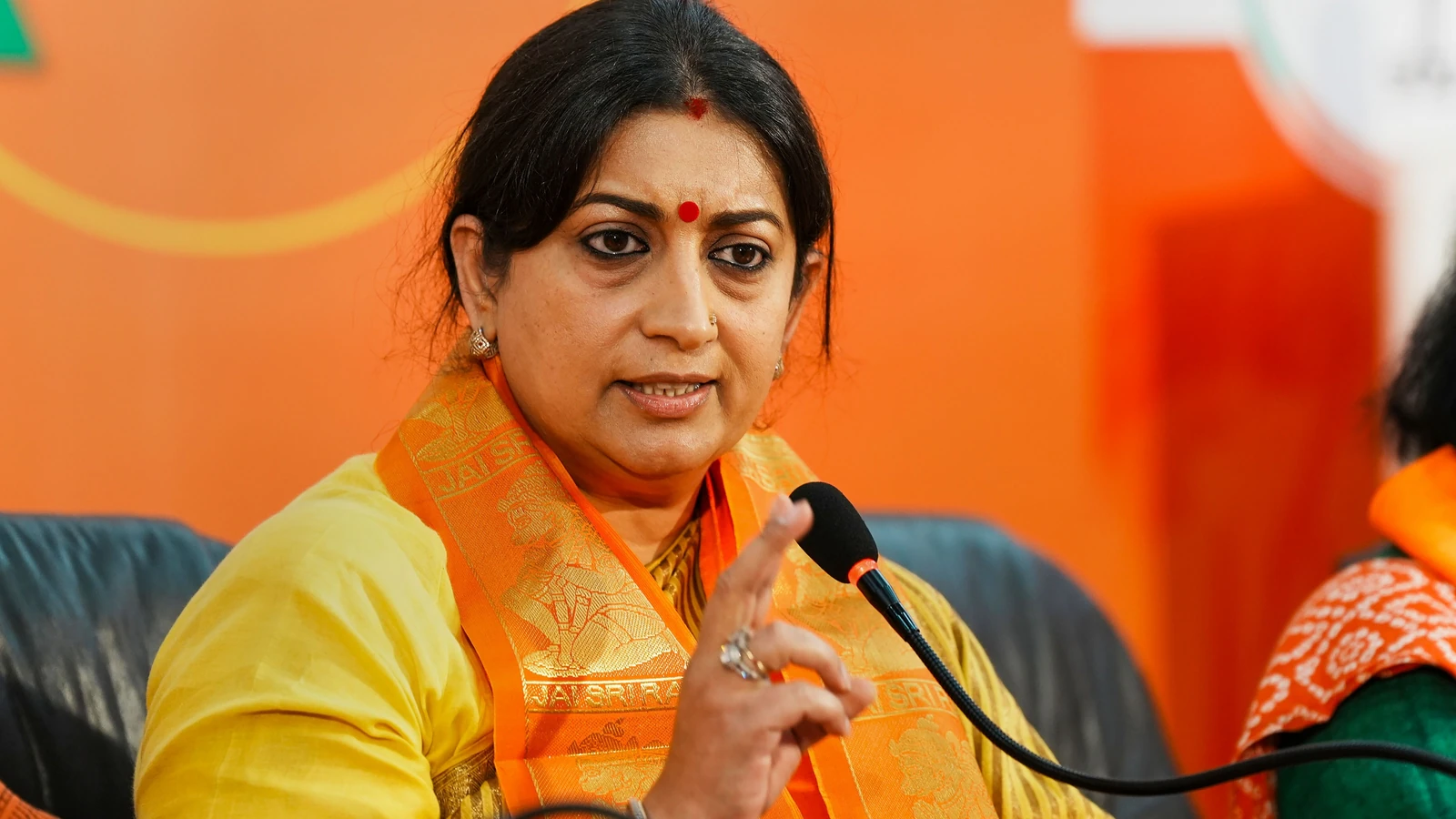How Smriti Irani Became a Game-Changer in Indian Politics?
Introduction:
Early Life and Education:
Smriti Zubin Irani was from a middle-class household in Delhi, where she was born on March 23, 1976. Shibani Bagchi, her mother is of Bengali descent, whereas Ajay Kumar Malhotra, her father is of Punjabi descent. She has three sisters, the first of whom is Smriti. Her broad perspective on societal issues is rooted in her multicultural upbringing.

Holy Child Auxilium School in New Delhi is where Smriti finished her schooling. She earned a Bachelor of Commerce degree from the University of Delhi. Smriti did a lot of different jobs while she was in college to pay for her education. One of these jobs was at McDonald’s. Her experiences taught her to be strong and self-reliant.
Stepping into the World of Entertainment:
Participating in the Miss India beauty contest in 1998 was Smriti Irani’s first step into the entertainment world. Although she didn’t win, her participation gave her more opportunities in the modeling and TV industry. Despite the difficulties she had in her early years, Smriti was able to achieve success.

Ekta Kapoor’s hit TV serial opera “Kyunki Saas Bhi Kabhi Bahu Thi,” in which she played the lead part of Tulsi Virani, was her real break. In 2000, the show aired and quickly became a smashing success, propelling Smriti to prominence. She became famous all over India with this role of a woman with strong beliefs and a strong resolve. The performance solidified her position as one of the most beloved actors in Indian television history, earning her countless awards and accolades.
Transitioning to Politics:
Smriti Irani’s decision to switch from the entertainment industry to politics was motivated by her desire to make a significant contribution to society. Given her great career in television, many were shocked when she joined the Bharatiya Janata Party (BJP) in 2003. But Smriti was motivated to serve the country and help commoners with their problems.
She ran for the Lok Sabha for the first time in 2004 from Delhi’s Chandni Chowk constituency. Although she was defeated by Kapil Sibal, a candidate for Congress, her aggressive campaign demonstrated her dedication to serving the people and set the stage for her future political pursuits.
Rise within the Bharatiya Janata Party (BJP):

As Smriti Irani took on more roles in the BJP, her political career got a boost. In 2004, she was made Vice-President of the Maharashtra Youth Wing. Later, she was made National Secretary of the BJP’s Women’s Wing. Her work in these roles showed how good a leader she was as well as her dedication to the party’s ideas.
In 2010, Smriti was made President of the Mahila Morcha, the BJP’s women’s wing. While in this role, she played an important role in getting women to vote and addressing issues relating to women’s empowerment. Her work made the BJP’s support base among women across the country much stronger.
The 2014 Lok Sabha Elections: A Turning Point:
Smriti Irani’s political career took a big turn during the 2014 Lok Sabha polls. In the Uttar Pradesh district of Amethi, she ran against Rahul Gandhi, who was the leader of the Congress party and was already a member of Parliament at the time. Given the long history of Gandhi dominance in Amethi, the BJP’s decision to field Smriti as their candidate was viewed as a bold move.
Comparatively new to politics, Smriti ran a fiery and bold campaign, even though her opponent was more experienced. Rahul Gandhi’s victory margin dropped by a large amount because of her work. This marked a change in the political scene in Amethi. Although she didn’t win the spot, her performance was praised by many, and she became a strong political leader.
Ministerial Roles and Achievements of Smriti Irani:
National Institutional Ranking Framework (NIRF):
Smriti Irani became the Minister of Human Resource Development (HRD) in Prime Minister Narendra Modi’s government after the BJP won the 2014 general elections. Throughout her time as HRD Minister, she carried out a number of significant projects that changed India’s educational system.
Launching the National Institutional Ranking Framework (NIRF) in 2015 was one of Smriti’s noteworthy accomplishments as HRD Minister. With the introduction of the NIRF, Indian educational institutions were ranked according to a range of criteria, including outreach, research, teaching, and learning. This project meant to improve transparency and accountability in higher education by giving a reliable metric to evaluate the quality of educational institutions.
Digital India Campaign in Education:
Smriti Irani was also a major force behind promoting the “Digital India” campaign in the education sector. Digital literacy and the incorporation of technology into classrooms were two of her primary goals in her advocacy for the use of technology to improve education. Several projects were started under her leadership to give students and teachers digital resources and tools in order to bridge the digital divide in education.

Skill Development and Vocational Training:
Acknowledging the value of skill development and vocational training, Smriti Irani introduced a number of initiatives to increase the employability of Indian youth. She campaigned for the incorporation of skill-based training into the curriculum and worked for creating opportunities for students to acquire practical experience in their chosen fields. The goal of these attempts was to close the gap between education and employment so that students would be better prepared for the job market.
Appointment to the Ministry of Textiles:
Smriti Irani was reassigned to the Ministry of Textiles in 2016, where she kept on demonstrating her impressive administrative skills. Under her regime, the Ministry started several programs to help artisans and weavers and promote the Indian textile industry.

India Handloom Brand:
In her time as Minister of Textiles, Smriti Irani launched the “India Handloom” brand, which was one of its most important projects. The goal of this project was to promote traditional handloom products and allow artists to show off their work. The India Handloom brand helped grow the market for traditional textiles both in India and around the world by guaranteeing quality and authenticity.
Comprehensive Handloom Cluster Development Scheme:
Additionally, Smriti Irani unveiled the Comprehensive Handloom Cluster Development Scheme, which aimed to provide handloom clusters with integrated, comprehensive development. The main goals of this plan were to improve infrastructure, offer training and skill development, and make it easier for people to get credit and reach markets. The goal of the project was to help weavers and artisans earn more.
A Historic Win in the 2019 Lok Sabha Elections:

One of the most important events in Smriti Irani’s political journey was the 2019 Lok Sabha elections. Still representing the Amethi constituency, she ran a stronger and more organized campaign this time around. Her unrelenting efforts, in conjunction with the backing of the BJP cadre, resulted in a win that will go down in history. Rahul Gandhi lost to Smriti Irani, ending the long-time dominance of the Gandhi family in Amethi. Both Smriti’s personal success and the political landscape in India changed dramatically as a result of this victory.
After Smriti Irani won the election, the second Modi government appointed her to two ministerial positions: textiles and women and child development. As Minister of Women and Child Development, she focused on addressing critical issues like child nutrition, women’s safety, and equal rights for men and women.
Poshan Abhiyaan (National Nutrition Mission):
“Poshan Abhiyaan” (National Nutrition Mission) was one of the most important projects that Smriti Irani started when she was Minister of Women and Child Development. The goal of this project was to fight malnutrition in women and children, with a focus on better nutrition and lowering the number of cases of stunting, wasting, and anemia. A multi-sectoral approach was used for the program, with different ministries and stakeholders working together to make sure it was fully and effectively implemented.
Campaign for “Beti Bachao Beti Padhao”:

Smriti Irani helped launch “Beti Bachao Beti Padhao.” It promoted girls’ education and addressed the dropping child sex ratio. The campaign was a success. It raised awareness of girls’ education and gender equality. The campaign aimed to empower girls. It aimed to give them access to education and opportunities. It used various initiatives and outreach programs to do this.
Continued political influence and initiatives:
As she assumed more responsibility inside the government, Smriti Irani’s influence grew.In 2021, they appointed her to lead the Ministry of Minority Affairs. This broadened her portfolio even further. She dedicated herself to inclusive development and social welfare. Her work in those ministries reflected that commitment.

Promoting Traditional Indian Textiles:
In the textiles sector, Smriti Irani kept pushing for the development of traditional Indian textiles and handicrafts. She started many programs to support artists and weavers and make sure their products were sold all over the world. Her efforts were instrumental in the revitalization of a number of traditional crafts and in providing a means of subsistence for a large number of artists all over the country.
Women’s Safety and Empowerment:
Smriti Irani made women’s empowerment and wellbeing her top priorities while serving as minister for women and child development. She started several programs that addressed problems like trafficking, sexual harassment, and domestic abuse. The goal of these programs was to make society a better place for women by defending their rights and elevating their status.
Personal Life and Resilience:
For many, Smriti Irani’s personal life has served as an inspiration throughout her journey. She got married to a businessman, Zubin Irani and they have two kids together, Zoish and Zohr. Even though her job as a politician is demanding, Smriti has handled her personal and work obligations with ease and strength.

Smriti Irani’s path has not been easy.She has encountered problems and faced criticism. She has faced intense media scrutiny and backlash. Many have attacked her. She has, however, triumphed over these challenges. Her resilience and determination let her continue her work with steadfast dedication.
Vision for the Future:
Smriti Irani, with a vision for a better India, will remain a key player in politics beyond 2024. She rose from a middle-class family in Delhi to a strong political leader. She determined, worked hard, and wanted to help people.

Education and Skill Development:
Smriti Irani knows India’s problems today. Her focus on education, skill development, and vocational training shows this. India’s success and development depend on raising education and skills. She envisions an education system that is inclusive and equal. It must also meet the job market’s needs. This would ensure that every student has the opportunity to be successful.
Women’s Empowerment and Gender Equality:
Smriti Irani’s future plans include efforts to promote gender equality and empower women. Her goal, through her many programs and efforts, is to make the country a better place for women so that they can work hard and be successful. She seeks a more society. She wants to empower women and provide equal education for girls.
Preservation and Promotion of Traditional Crafts:
Smriti Irani is dedicated to advancing India’s rich textile crafts. She dreams of a time when artists and weavers are encouraged and their work is praised all over the world. Her goal is to raise craftsmen’s living standards. She also wants to sustain traditional crafts. These are key parts of her vision for the future.
Promotion of Social Welfare and Inclusive Development:
At the Ministry of Minority Affairs, Smriti Irani showed her commitment to social welfare and inclusion. No matter their background, she wants all citizens to have access to resources and opportunities. Her activities aim to integrate underprivileged communities into the nation’s progress. They focus on education, skills, and economic empowerment.
Conclusion:
Smriti Irani’s rise to a top role in Indian politics, from a middle-class Delhi home, shows her will and dedication to public service. Her story transcends politics. It inspires many to work hard, stay dedicated, and overcome challenges.
Irani’s impact extends far beyond her meteoric rise in the political landscape. Her push for education reform, like the NIRF ranking, has made higher ed more transparent. It has also made it more accountable. Her work to close the digital divide will improve classrooms. It will create a future-proof education system.
Beyond education, Irani’s dedication to empowering women and ensuring their safety is undeniable. The “Beti Bachao Beti Padhao” campaign is a symbol of her fight against gender inequality. It shows her strong support for girls’ education. As Minister of Women and Child Development, she launched vital programs. One was “Poshan Abhiyaan,” which tackled malnutrition in women and children.
The textile industry witnessed a significant revitalization under Irani’s leadership. Her support for traditional crafts and artisans helped the sector. Initiatives like the “India Handloom” brand preserved India’s rich heritage. She aims to promote sustainability and improve weavers’ lives. This will preserve their age-old traditions.
As Smriti Irani looks to the future, she wants a more inclusive and prosperous India. Her focus on education and skills will prepare a new generation. They will have the tools to navigate the changing job market. Her social welfare work aims to include all communities in India’s growth. Smriti Irani’s story is far from over. Her strong spirit and commitment to public service will drive positive change. Whether she stays in her cabinet roles or takes a new path, her impact on India is undeniable. Smriti Irani’s legacy is one of perseverance and social good. She sought a brighter future for all.

